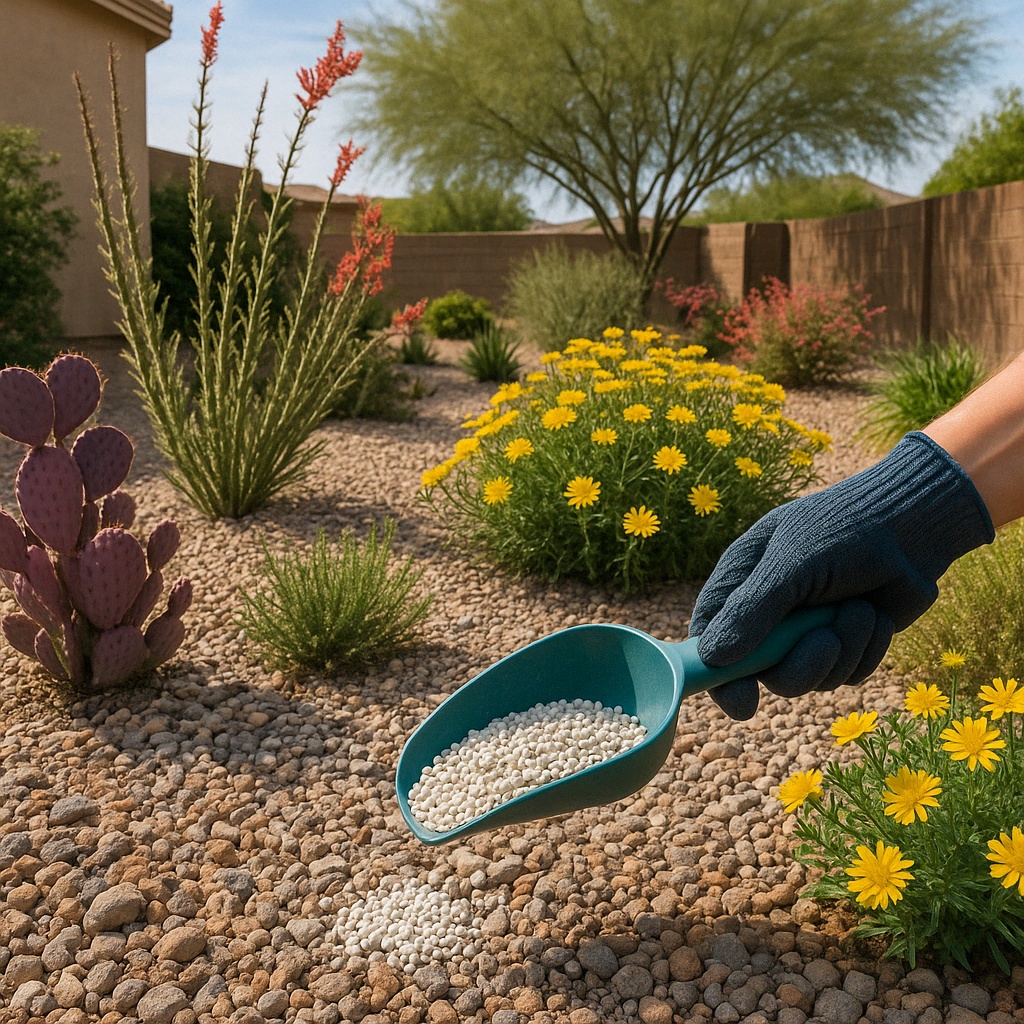Desert gardening in Gilbert, AZ demands a unique approach — especially when it comes to fertilizing. Native plants and water-wise ornamentals need targeted care to thrive in extreme heat and alkaline soils. Over-fertilizing can do more harm than good, while the right seasonal approach builds root strength, color, and bloom resilience. This guide walks you through everything from soil testing to smart application timing so your desert-friendly landscape gets the boost it needs — and nothing it doesn’t.

Start by Knowing Your Soil
Gilbert soils range from sandy to clay-heavy, and many yards feature compacted, alkaline profiles that limit plant nutrient access. That’s why step one is a soil test. A simple kit from a garden center or online store can reveal your pH (typically around 7.5–8.0 in this region) and highlight deficiencies in key nutrients like nitrogen (N), phosphorus (P), and potassium (K).
If your test shows iron, phosphorus, or organic matter is lacking — common in the desert — that’s a good clue to amend your fertilizing approach. Compost, worm castings, or iron chelate can all be helpful additions before you even reach for bagged fertilizer.
Choosing the Right Fertilizer
Not all fertilizers are created equal — and the wrong blend can stress desert plants. Opt for low-nitrogen, slow-release, or organic fertilizers that feed gently and consistently. Avoid quick-release synthetic blends that promote rapid leafy growth, which is harder for desert plants to maintain under heat stress.
- Succulents & Cacti: Use a cactus-specific blend with added micronutrients like magnesium and iron — once per season is usually enough.
- Native Shrubs & Perennials: Look for 5-5-5 or 8-8-8 slow-release granules. Organic options like composted chicken manure or seaweed emulsion can offer a boost without disrupting root health.
- Desert Trees: Fertilize once annually in early spring with tree spikes or deep-root injections formulated for dry-climate species.
Bonus tip: Gilbert’s hard water can exacerbate salt buildup in the soil, so organic inputs can help avoid compounding the problem.
When to Fertilize in the Desert
Timing matters. Desert plants grow best during the “shoulder seasons” — when temperatures are mild and rainfall may still occur. That makes March–April and October–early November the two best windows for fertilizer application in Gilbert.
Avoid feeding during summer when many plants go dormant to conserve energy. Fertilizing during peak heat can encourage tender new growth that’s easily scorched and water-demanding.
Smart Fertilizer Application Tips
- Target the root zone: Apply fertilizer in a doughnut shape around plants — not directly against stems or trunks.
- Hydrate afterward: Water deeply after applying fertilizer to help nutrients move into the soil and reduce the risk of burn.
- Time around weather: Don’t fertilize before major rain to avoid nutrient runoff, especially on slopes or gravel-heavy yards.
Using a hand rake to gently scratch granules into the top layer of soil can improve absorption, especially in hard clay zones.
Fertilizer Mistakes to Avoid
- Over-fertilizing: More isn’t better. Excess nutrients can burn roots, increase salt content, and stimulate weak growth vulnerable to heat and pests.
- Using turf products: Lawn fertilizers often contain too much nitrogen and herbicides — not safe for ornamental or native plants.
- Feeding mature natives: Once established, many desert natives like Texas Ranger, brittle bush, or desert willow need little to no fertilization.
Building Long-Term Soil Health
If you’re fertilizing every year but still seeing yellowing leaves or stunted growth, the issue may be more about poor organic matter or compacted soil. Layering compost each spring or mixing in native mulch around perennials helps restore structure, retain moisture, and support beneficial microbes. Fertilizer should complement — not replace — overall soil health.
Feed Your Plants the Right Way
With the right timing, product, and strategy, fertilizing in Gilbert’s arid climate becomes a tool for resilience, not stress. Whether you’re growing vibrant lantana or sheltering palo verde trees, careful fertilization helps desert-adapted plants reach their full potential while staying water-smart. You’ll get stronger blooms, deeper roots, and a yard that thrives through the toughest months.
Want more local advice? Read our guide to Top Drought-Resistant Plants for Arizona Gardens and Spring Lawn & Landscape Tips for Gilbert’s Desert Yards.
Related Articles
- Installing Efficient Irrigation Systems in Gilbert
- Top Drought-Resistant Plants for Arizona Gardens
- April Yard Checklist for Gilbert
Written by Tina Delgado, a desert horticulturist and Mesa Community College instructor. Tina shares practical, soil-smart advice rooted in her years of hands-on experience helping Gilbert homeowners grow thriving landscapes in a challenging climate.






